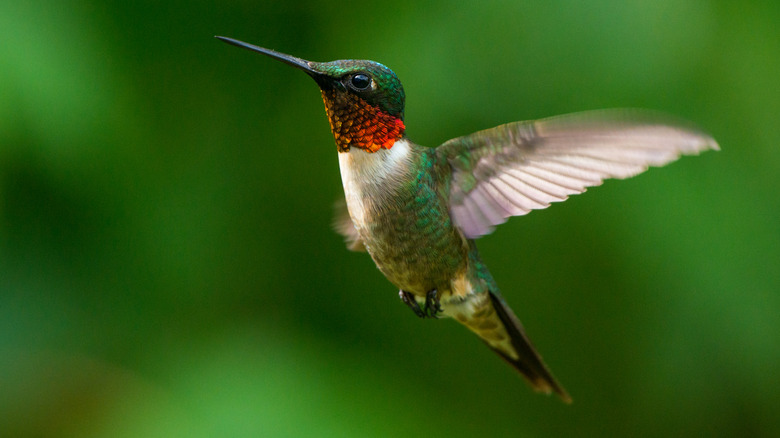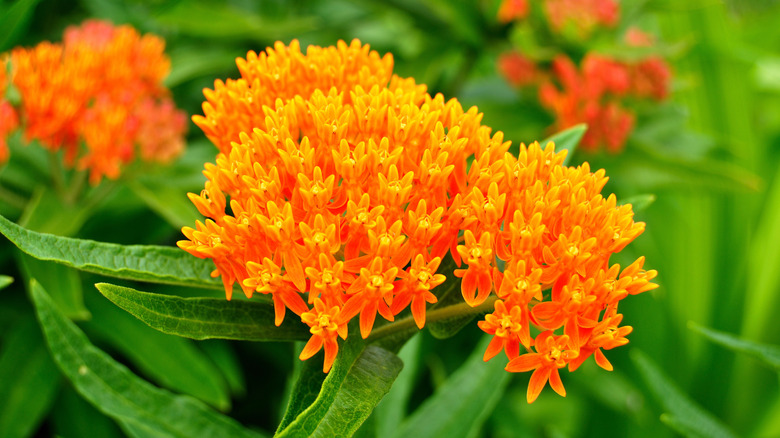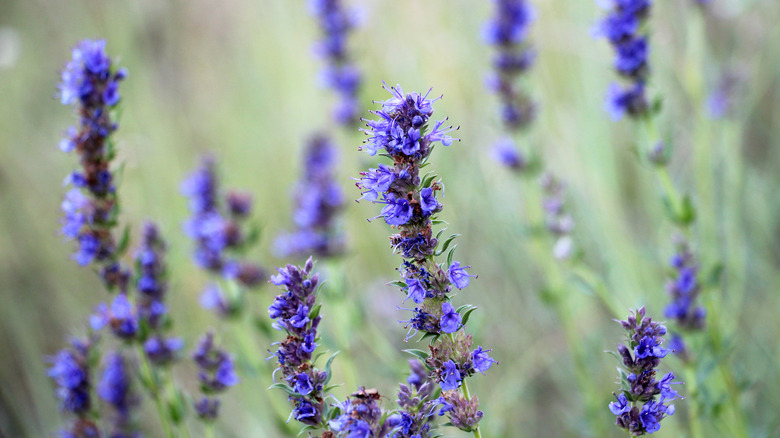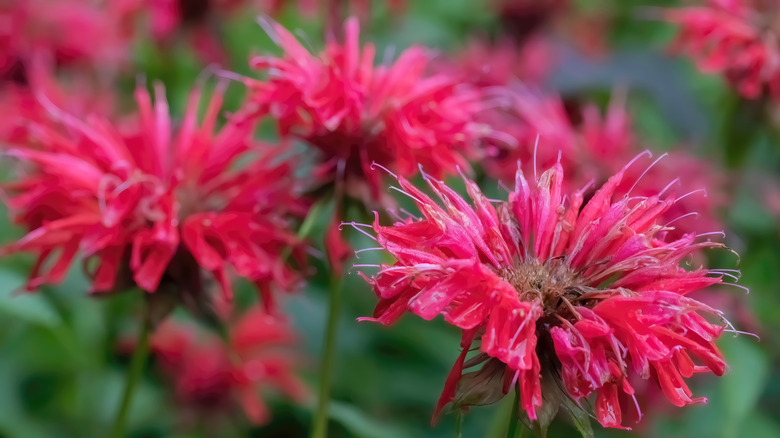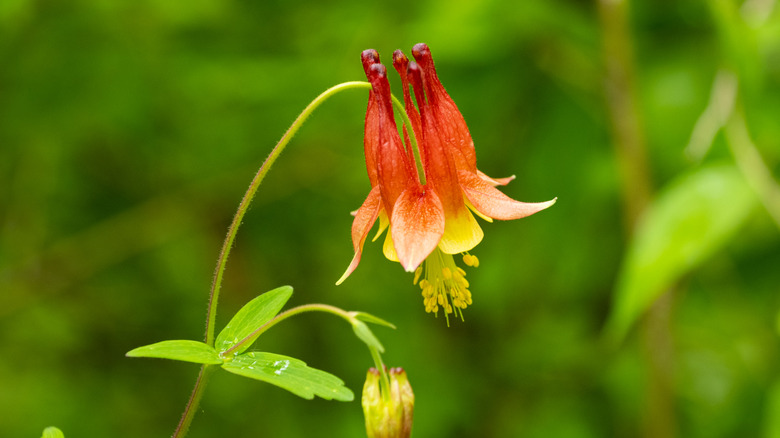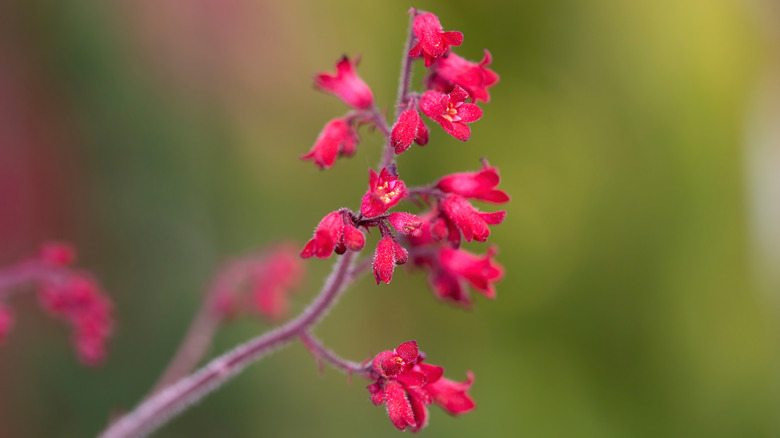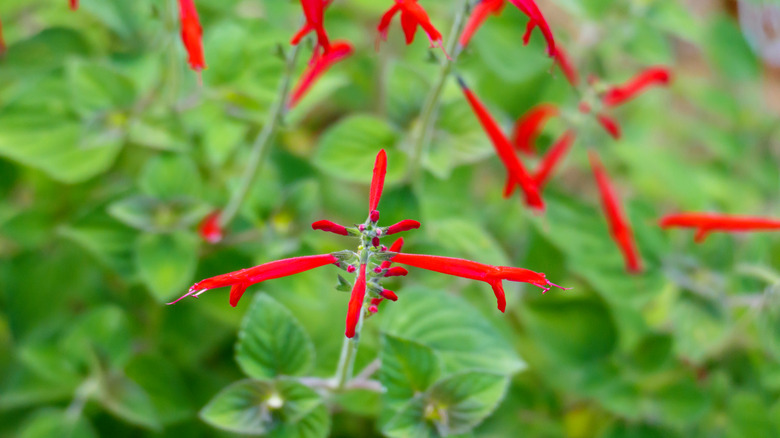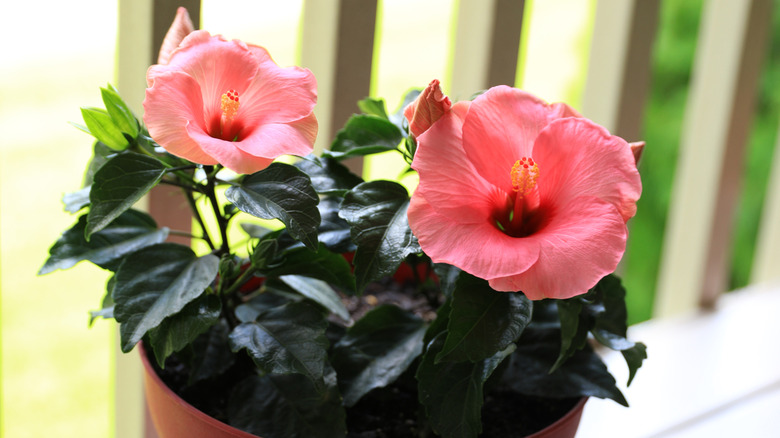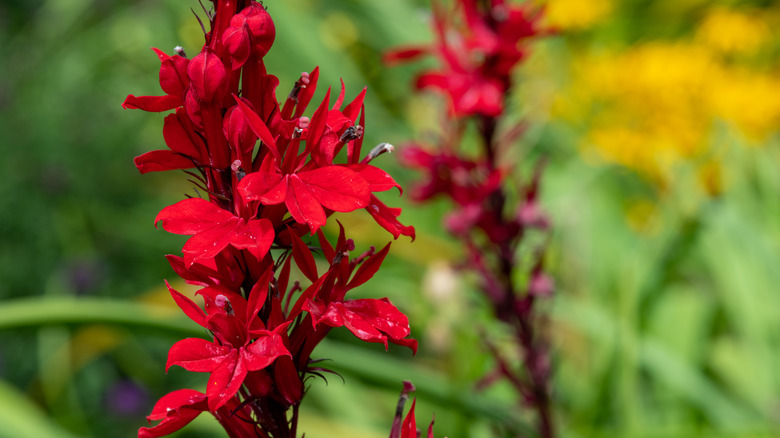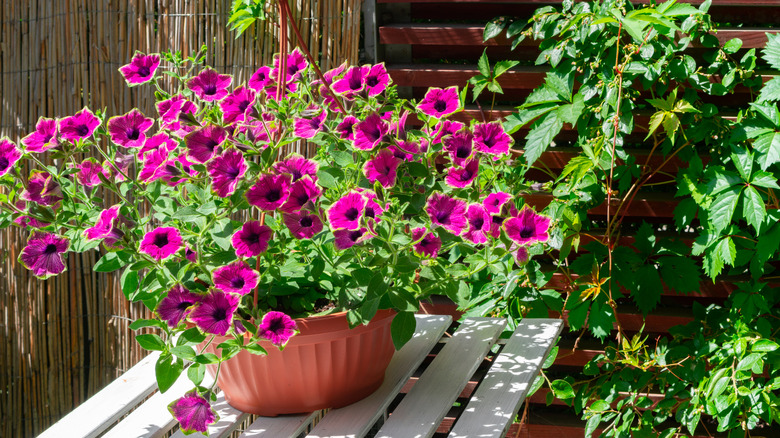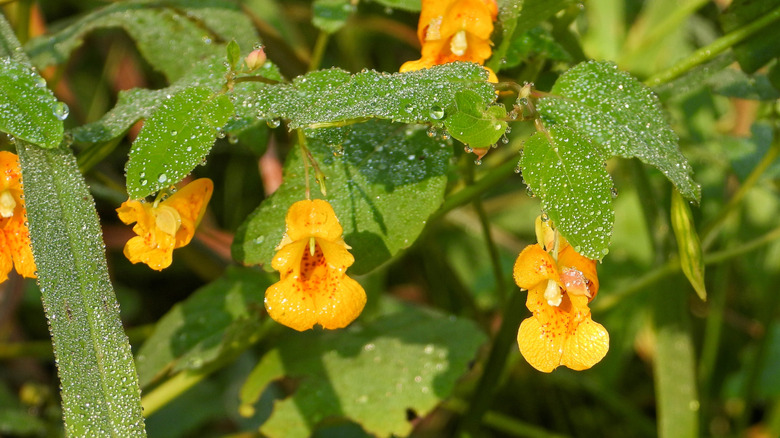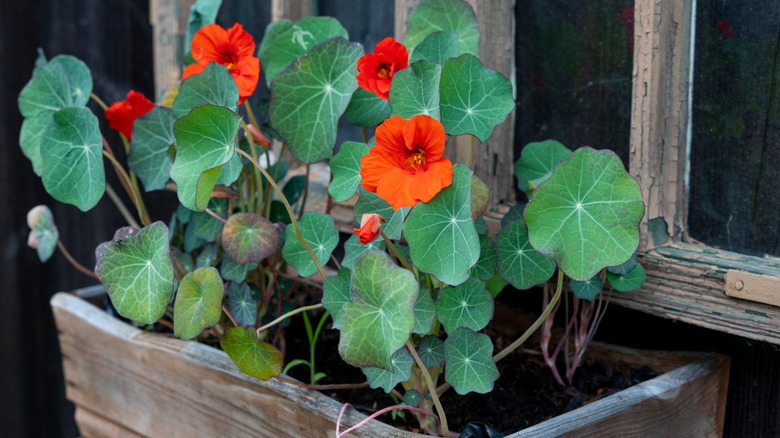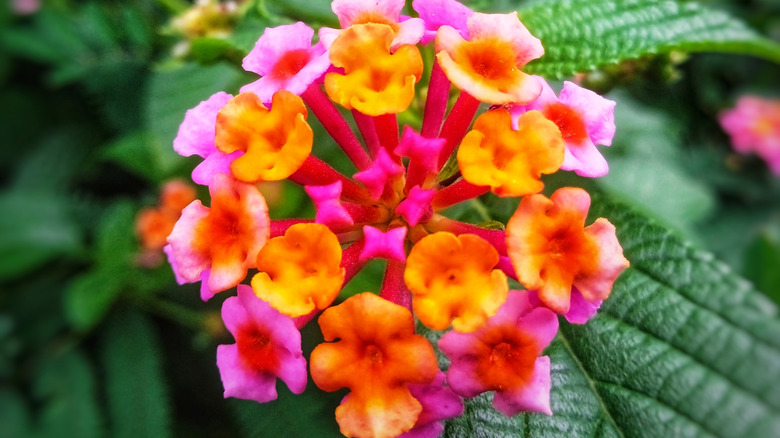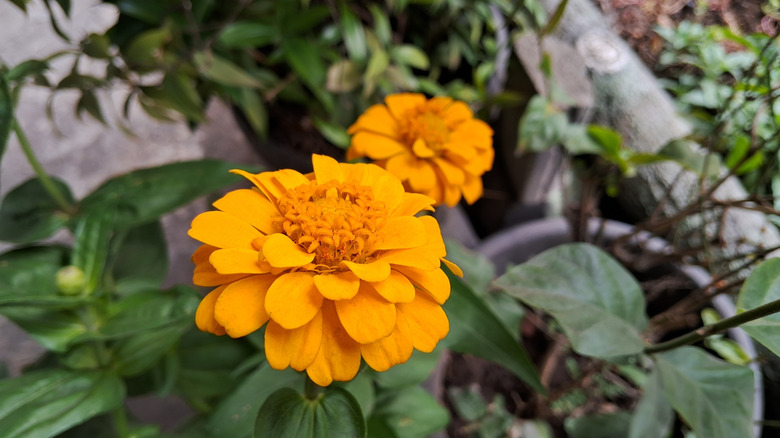13 Container Plants That Will Entice More Hummingbirds To Visit The Yard Or Garden
Spotting a hummingbird in your garden never gets boring. Their long beaks and acrobatic antics are a sight straight out of a nature documentary, and since all that flying takes a lot of energy, hummingbirds can eat up to three times their body weight every day. It's not surprising, then, that one of the best ways to attract more hummingbirds to your yard or garden is to provide plenty of sources of nectar — their favorite food. Regardless of how much space you have, containers are an effective way to add more hummingbird-friendly plants to your garden.
Hummingbirds use their sight to find food, so they're attracted to bright flowers with abundant nectar. These high-appetite birds will feast on any color of flower, but it's best to include at least some red, which hummingbirds can easily see from far away. Tubular or trumpet-shaped flowers are also popular with hummingbirds, since their long beaks fit them perfectly. Lastly, to really make your yard a hummingbird paradise, include native plants when possible; hummingbirds are used to looking for these plants as a reliable source of local food. Container plants that meet these criteria and hummingbirds are sure to feast on include butterfly weed, coral bells, salvia, lantana, and zinnias, among others.
To increase your chances of success, choose the container location wisely. A quieter area of the yard, away from pets or kids, can be more attractive to hummingbirds, and it's best to place your containers in a few different spots, since these territorial birds often chase others away. Consider hanging baskets that allow birds to easily go back and forth from nearby trees.
Butterfly weed
One native plant that's just as popular with hummingbirds as it is with gardeners is butterfly weed (Asclepias tuberosa). These bright, orange-red flowers stand out to hummingbirds in addition to attracting other pollinators, like butterflies, and they bloom from May to September. Butterfly weed also grows well in containers because it's compact, low maintenance, and drought tolerant. It requires full sun and is cold hardy in USDA zones 3 to 9.
Hyssop
Hyssop (Hyssop officinalis) is one example of a plant that remains popular with hummingbirds despite not having red blooms. It features bright purple-blue flowers that bloom all through the summer; both the flowers and leaves give off an appealing fragrance. The tubular shape of the blooms is ideal for hummingbirds, while the plant's small size is perfect for container gardens. Hyssops require full sun but appreciate shade on hot afternoons. They are drought tolerant and cold hardy in zones 4 to 9, though they require re-planting every few years.
Bee balm
Bee balm (Monarda didyma), native to the eastern U.S., has tubular flowers in a vibrant shade of red — a hummingbird's favorite. Clump a few of these together to attract more birds, as well as butterflies, bees, and moths. The flowers also happen to be edible for humans and have a lovely smell. Bee balm is easy to grow; it prefers full sun and requires humus–rich, well-draining soil. Keep the soil consistently moist. It's cold hardy in zones 4 to 9.
Eastern red columbine
Another native plant, Eastern red columbine (Aquilegia canadensis) makes a great add to hummingbird gardens. It can start blooming as early as February, depending on the region, providing a helpful early food source to hummingbirds. It has red and yellow tube-shaped flowers. This hardy plant can tolerate cold, heat, and drought, but it does best in partial to full shade since full sun can burn its leaves. It's flexible as far as soil goes, as long as it's well-draining. Eastern red columbine is cold hardy in zones 3 to 8.
Coral bells
The name "coral bells" may refer to any plant in the Heuchera genus, all of which are native to North America. They're known for their clusters of small, bell-shaped flowers, which are rich in nectar, making them a magnet to hummingbirds. They come in red, orange, pink, or white and bloom in late spring to early summer. Heuchera works well in hanging baskets, since it will trail prettily over the edges. Some have colorful leaves. Their care requirements and cold hardiness depends on the species, with a general range of zones 3 to 9, so you can choose a variety that works best for your region.
Salvia
Salvia is another popular genus with hummingbirds. There are almost 1,000 species to choose from, with around 50 that are native to the U.S.; the color of the flowers varies from blue to pink and beyond. These plants provide abundant nectar and generally do well in containers. Salvia varieties that hummingbirds adore include 'Saucy' red salvia (Salvia splendens), autumn sage (Salvia greggii), and pineapple sage (Salvia elegans), all of which feature red tubular flowers. Salvias typically require full sun.
Hibiscus
The huge, nectar-rich blooms of hibiscus are hard for hummingbirds to resist, and they persist all through the summer. Some hibiscuses are hardy, while others are tropical plants that are grown as annuals. While you can't go wrong with adding any hibiscus flower to your hummingbird feeder, you may want to choose a more compact variety for your containers, such as rose hibiscus (Hibiscus rosa-sinensis), a tropical hibiscus hardy only in zones 9 to 11. It requires full sun and consistently moist soil. Hardy hibiscuses usually require large containers.
Lobelia
Hummingbirds enjoy lobelias, a wide-ranging genus with bell-shaped flowers. They come in both trailing and mounding varieties and bloom twice, in spring and fall; they may also flower through summer if the climate is cool enough. One lobelia species that's native to the U.S. and attractive to hummingbirds is the cardinal flower (Lobelia cardinalis). The flowers are a signature hummingbird red, and this plant works perfectly for shady corners of the yard, though it also thrives in full sun. Keep the soil in the container consistently moist to mimic the plant's natural habitat. It's hardy in zones 3 to 9.
Petunia
Petunias are another popular container flower that appeals to people just as much as it does to hummingbirds. Petunias are usually grown as annuals, though they are hardy in zones 9 to 11. They come in tons of colors and shapes with a long blooming season — from spring until the first frost. Petunias appeal to hummers due to their bright tube-shaped flowers. One rarer species, Petunia exserta, is pollinated by hummingbirds in the wild and is a surefire hummer magnet if you can find it. They require full sun.
Impatiens
Add impatiens to your list of shade-tolerant yet hummingbird-friendly container plants. These annual plants are profuse bloomers. Consider going with the native jewelweed (Impatiens capensis) species to attract more birds — they're much richer in nectar than the non-native varieties often used as bedding plants. Jewelweed is also pollinated by hummingbirds in the wild. This variety has interesting orange flowers and a long blooming season that lasts from summer until frost. It's popular with bumblebees as well. It does tend to spread quickly, making containers a practical choice to prevent unwanted growth.
Nasturtium
Nasturtiums, an edible garden favorite, are a magnet to hummingbirds thanks to their large, yellow-red flowers and highly sweet nectar. Other pollinators enjoy nasturtiums too, but only hummingbirds can reach deep into the flowers to get every available drop. Nasturtiums require full or partial sun and are drought tolerant; they can thrive in poor soil. Go with the compact, bushy nasturtium species, Tropaeolum minus, for containers. These come in a range of varieties and are hardy in zones 2 to 11.
Lantana
Lantana is a plant genus with lots to offer for hummingbirds. It's heat tolerant, so it will continue providing beautiful, bright flowers even in the middle of the summer when other flowers languish. With many species available, it can work well in hanging baskets or as a filler in containers. The flowers typically come in pink, yellow, orange, or red. Most are grown as annuals, though the common lantana (Lantana camara) is hardy in zones 7 to 11. It requires full sun and can be weedy in warmer areas. Common lantana is poisonous to humans and pets.
Zinnias
With a number of species and cultivars to choose from, zinnias are popular flowers that come in different colors. But each one of them is bright and hummingbird friendly. They're also low-maintenance and easy to grow; most are grown as annuals and require well-draining soil and sunny conditions. Look for shorter and more compact varieties for containers, such as Zinnia elegans 'Zahara,' 'Thumbelina,' or 'Magellan.'
